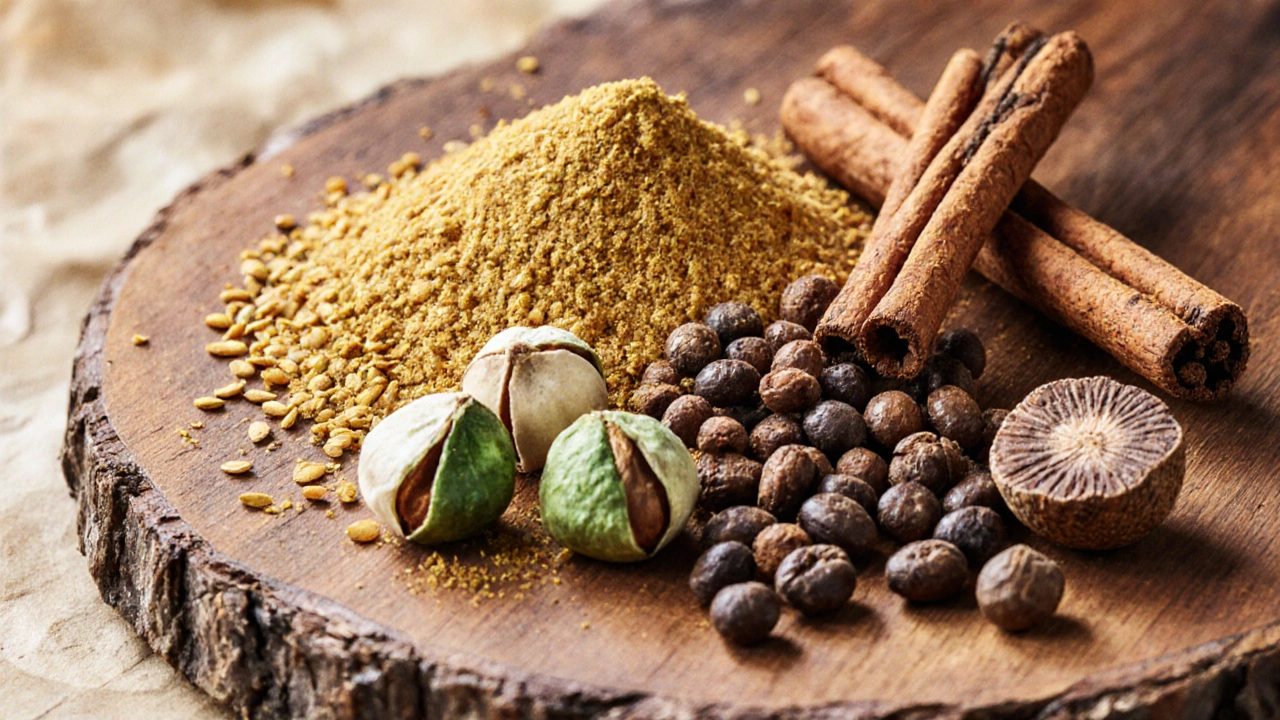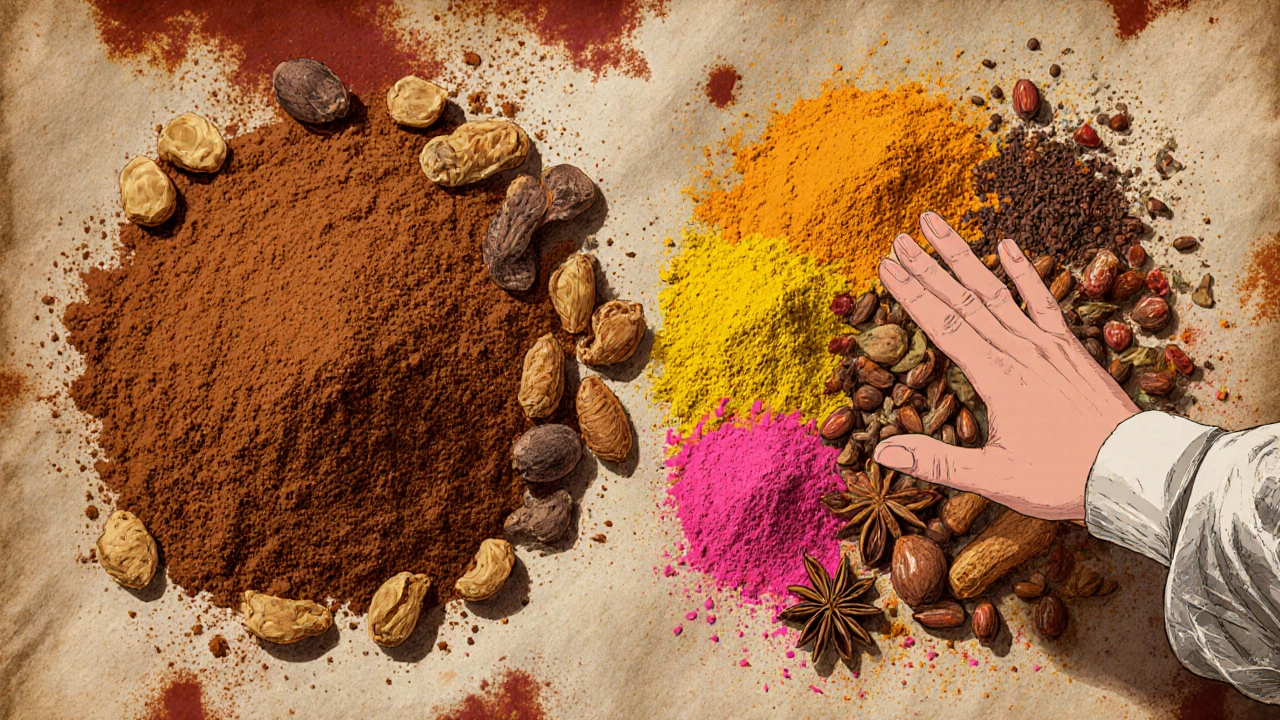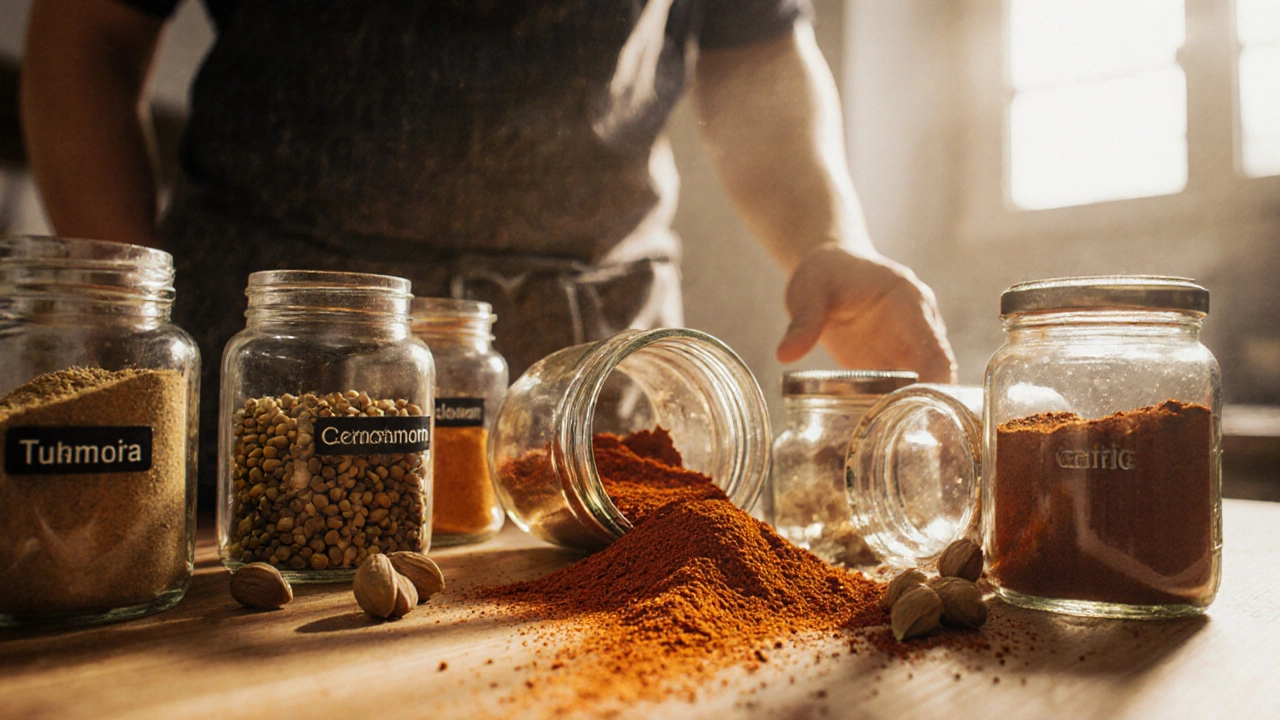Garam Masala Spice Checker
Check a Spice
Enter a spice name to see if it belongs in traditional garam masala.
Ever mixed up a spice and wondered why your garam masala tasted off? You’re not alone. Many home cooks assume any Indian spice can join the blend, but traditional recipes have clear boundaries. This guide lists the spices that simply don’t belong, explains why, and gives you a quick cheat‑sheet to keep your mix authentic.
Quick Takeaways
- Traditional garam masala never includes turmeric, fenugreek leaves, or dried mango powder.
- Core spices are cumin, coriander, cardamom, cloves, cinnamon, black pepper, and nutmeg.
- Adding sweet or sour spices (like paprika or amchur) throws off the warm, aromatic balance.
- Use the table below as a reference when grinding your own blend.
- Stick to whole spices and toast them for the best flavor.
What Is Garam Masala is a blended mixture of whole spices traditionally used in North Indian cooking to finish dishes with warmth and depth?
The name literally means “hot spice” in Hindi, but it’s not about heat. It’s about aroma. Most families have their own version, yet every authentic recipe shares a core set of warm, sweet, and slightly pungent spices. The blend is usually added at the end of cooking, letting the volatile oils shine without being over‑cooked.
Core Spices That Define the Blend
These seven spices form the backbone of any genuine garam masala. They appear in most classic recipes and are the only ones you can’t afford to miss.
- Cumin (earthy, nutty seed) - 12‑15% of the blend
- Coriander (citrusy, floral seed) - 10‑12%
- Cardamom (sweet, eucalyptus‑like pods) - 5‑8%
- Cloves (intense, warm buds) - 3‑5%
- Cinnamon (sweet, woody bark) - 5‑7%
- Black Pepper (sharp, piney grind) - 5‑8%
- Nutmeg (sweet, nutty seed) - 2‑4%

Spices That Are Not Part of Traditional Garam Masala
Here’s where the confusion usually happens. Below are the most common culprits you’ll find people tossing into their garam masala, and why they don’t belong.
- Turmeric - bright yellow, earthy bitterness. It’s a staple in curries but adds a color and flavor profile that masks the warm aromatics of the blend.
- Fenugreek Leaves (Kasuri Methi) - smoky, slightly bitter herb. It’s used as a finishing herb, not a foundational spice.
- Amchur (Dried Mango Powder) - tangy, sour note. Garam masala aims for warmth, not sourness.
- Red Chili Powder or Paprika - heat or smoky sweetness. The blend already carries subtle heat from black pepper; extra chili overwhelms.
- Star Anise - sweet licorice flavor. It clashes with the mellow sweetness of cinnamon and cloves.
- Fennel Seeds - sweet, anise‑like. While used in some regional masalas, the classic North Indian version keeps them out.
- Mustard Seeds - sharp, pungent bite. They belong to tempering (tadka) rather than the dry spice blend.
- Saffron - delicate, floral aroma. It’s a luxury garnish, not a component of the base blend.
Why Those Spices Are Excluded - The Flavor Science
Garam masala is designed to be a warm, aromatic finish. Each core spice contributes a specific note:
- Cumin gives earthiness.
- Coriander adds citrus brightness.
- Cardamom brings sweet floral nuance.
- Cloves and Cinnamon supply deep warmth.
- Black Pepper provides a subtle sting.
- Nutmeg rounds off the profile with a gentle nutty finish.
When you introduce a sour (amchur), overly sweet (star anise), or brightly colored (turmeric) spice, the balance shifts. The blend loses its signature “warmth‑first” character and can even taste unbalanced in delicate dishes like dal or paneer kofta.
How to Keep Your Blend Pure - Practical Tips
- Write down the core seven spices before you start grinding. Keep the list visible on your countertop.
- Buy whole spices, not pre‑ground. Whole seeds retain essential oils that release during toasting.
- Toast each spice lightly in a dry pan until fragrant-usually 30‑45 seconds. This step is crucial for depth.
- Avoid multitasking while toasting. Over‑toasting turns spices bitter, which mimics the effect of adding the wrong spice.
- Cool the spices completely before grinding. Warm spices can clump, leading to uneven distribution and accidental addition of extra amounts.
- Store the final blend in an airtight glass jar, away from sunlight. A fresh batch lasts about three months; after that, the flavors start to fade, tempting you to “boost” with extra spices-resist!

Cheat‑Sheet Table: Used vs. Not Used in Traditional Garam Masala
| Spice | Typically Used? |
|---|---|
| Cumin | Yes |
| Coriander | Yes |
| Cardamom | Yes |
| Cloves | Yes |
| Cinnamon | Yes |
| Black Pepper | Yes |
| Nutmeg | Yes |
| Turmeric | No |
| Fenugreek Leaves (Kasuri Methi) | No |
| Amchur (Dried Mango Powder) | No |
| Red Chili Powder | No |
| Star Anise | No |
| Fennel Seeds | No |
| Mustard Seeds | No |
| Saffron | No |
Simple DIY Garam Masala (No Wrong Spices)
- Measure out the following whole spices:
- 2tbsp cumin seeds
- 2tbsp coriander seeds
- 1tbsp green cardamom pods (seeds removed)
- 1tsp whole cloves
- 1tsp cinnamon sticks (break into pieces)
- 1tsp black peppercorns
- ½tsp freshly grated nutmeg or ¼tsp whole nutmeg
- Toast the mixture in a skillet over medium‑low heat, shaking the pan constantly. When the spices turn fragrant (about 40 seconds), remove from heat.
- Let the spices cool completely, then grind them in a spice grinder or mortar‑pestle until fine.
- Store in a dark glass jar. Use a teaspoon per serving of curry, stew, or soup.
Now you have a clean, authentic garam masala spices blend that won’t be ruined by accidental additions.
Frequently Asked Questions
Can I add turmeric to garam masala if I want a yellow color?
Turmeric changes both the color and the flavor dramatically. Traditional garam masala stays brown‑gold because it relies on toasted spices. If you need yellow, add a pinch of turmeric to the final dish instead of the blend.
Is it okay to substitute dried cardamom powder for whole pods?
Whole pods preserve essential oils better. If you must use powder, keep the amount low (about half the quantity) to avoid an overpoweringly sweet note.
Why do some regional recipes list fennel seeds?
In parts of Gujarat and Rajasthan, a slightly sweeter masala is preferred, and fennel fits that palate. However, the classic North Indian version excludes it, so stick to the core list unless you’re cooking a regional specialty.
How long can I keep homemade garam masala?
Stored in an airtight container away from light, it stays fresh for about three months. After that, the volatile oils fade and the blend may lose its punch.
Will adding extra black pepper make the blend too spicy?
Black pepper provides a mild heat, but the blend is not meant to be hot. Stick to the 5‑8% range; if you need more kick, add fresh chiles at the cooking stage instead.
